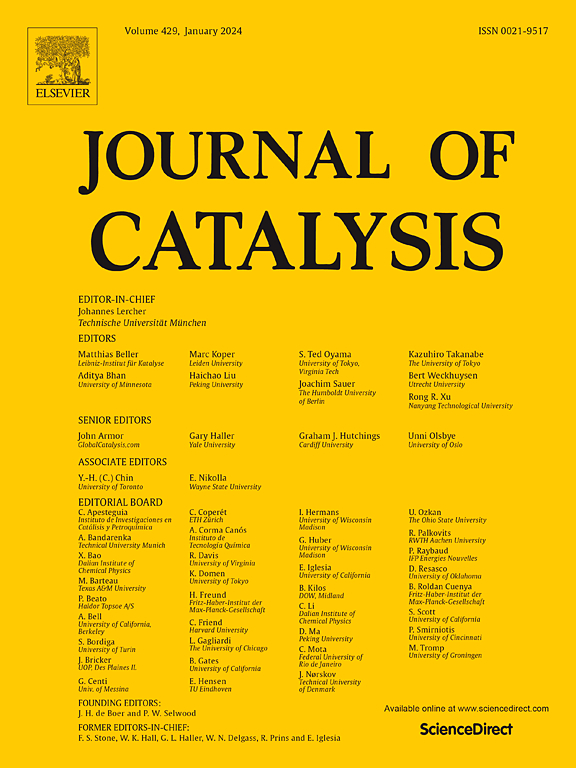Atomically dispersed noble metal-free Cu(I) sites in Ce-MOF-808 with enhanced catalytic hydrogenation performance
IF 6.5
1区 化学
Q2 CHEMISTRY, PHYSICAL
引用次数: 0
Abstract
Single-atom catalysts (SACs) catalysts have unique electronic properties and geometric structures, offering maximum atom-utilization efficiency. Noble metal-free SACs anchored within metal–organic frameworks (MOFs) enable precise tuning of electronic structures and significantly enhance catalytic activity beyond conventional porous materials. Herein, we synthesized the synthesis of Cu(I)/Ce-MOF-808-EA by anchoring atomically dispersed Cu(II) species onto the open Ce6 nodes of the Ce-MOF-808 framework, followed by in situ reduction to Cu(I) via ethanol treatment and thermal activation processes. The atomic dispersion and valence transformation of Cu sites on Ce-MOF-808 were confirmed by X-ray Absorption Spectroscopy (XAS), high-angle annular dark-field scanning transmission electron microscopy (HAADF-STEM), and X-ray photoelectron spectroscopy (XPS). The resulting Cu(I)/Ce-MOF-808-EA exhibited outstanding catalytic performance for the hydrogenation of Dicyclopentadiene (DCPD), achieving 100 % conversion, 91.54 % selectivity toward Dihydrodicyclopentadiene (DHDCPD), and 8.45 % selectivity toward Tetrahydrodicyclopentadiene (THDCPD) at 100 °C, 2 MPa. Notably, Cu(I)/Ce-MOF-808-EA outperformed other transition metal catalysts (Co/Ce-MOF-808-EA, Ni/Ce-MOF-808-EA and Zn/Ce-MOF-808-EA). For the first time, Density Functional Theory (DFT) calculations, combined with experimental investigations, revealed a low-energy reaction pathway for DCPD hydrogenation, wherein Cu(I) sites, in cooperation with adjacent oxygen atoms, act as bi-active centers to heterolytically cleave H2 into proton and hydride species (*Hδ+-Hδ-) for subsequent hydrogenation. This study underscores the potential of MOFs as versatile platforms for engineering single-atom catalysts with enhanced catalytic properties.


Ce-MOF-808原子分散无贵金属Cu(I)位点,增强催化加氢性能
单原子催化剂(SACs)具有独特的电子性质和几何结构,提供了最大的原子利用效率。锚定在金属有机框架(mof)内的无贵金属SACs能够精确调节电子结构,并显著提高传统多孔材料的催化活性。在此,我们将原子分散的Cu(II)物种锚定在Ce-MOF-808框架的Ce6开放节点上,然后通过乙醇处理和热活化过程原位还原为Cu(I),从而合成了Cu(I)/Ce-MOF-808- ea。利用x射线吸收光谱(XAS)、高角环形暗场扫描透射电镜(HAADF-STEM)和x射线光电子能谱(XPS)证实了Ce-MOF-808上Cu位点的原子色散和价态转变。所得Cu(I)/Ce-MOF-808-EA对双环戊二烯(DCPD)的加氢表现出优异的催化性能,在100 °C, 2 MPa下,对二氢双环戊二烯(DHDCPD)的转化率为100 %,选择性为91.54 %,对四氢双环戊二烯(THDCPD)的选择性为8.45 %。值得注意的是,Cu(I)/Ce-MOF-808-EA催化剂的性能优于其他过渡金属催化剂(Co/Ce-MOF-808-EA、Ni/Ce-MOF-808-EA和Zn/Ce-MOF-808-EA)。密度泛函理论(DFT)计算结合实验研究首次揭示了DCPD加氢的低能反应途径,其中Cu(I)位点与相邻的氧原子合作,作为双活性中心,将H2异裂为质子和氢化物(*Hδ+-Hδ-),进行后续的加氢。这项研究强调了mof作为具有增强催化性能的工程单原子催化剂的通用平台的潜力。
本文章由计算机程序翻译,如有差异,请以英文原文为准。
求助全文
约1分钟内获得全文
求助全文
来源期刊

Journal of Catalysis
工程技术-工程:化工
CiteScore
12.30
自引率
5.50%
发文量
447
审稿时长
31 days
期刊介绍:
The Journal of Catalysis publishes scholarly articles on both heterogeneous and homogeneous catalysis, covering a wide range of chemical transformations. These include various types of catalysis, such as those mediated by photons, plasmons, and electrons. The focus of the studies is to understand the relationship between catalytic function and the underlying chemical properties of surfaces and metal complexes.
The articles in the journal offer innovative concepts and explore the synthesis and kinetics of inorganic solids and homogeneous complexes. Furthermore, they discuss spectroscopic techniques for characterizing catalysts, investigate the interaction of probes and reacting species with catalysts, and employ theoretical methods.
The research presented in the journal should have direct relevance to the field of catalytic processes, addressing either fundamental aspects or applications of catalysis.
 求助内容:
求助内容: 应助结果提醒方式:
应助结果提醒方式:


